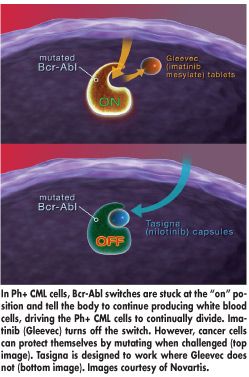Accelerated approval for Tasigna
FDA has granted accelerated approval to Novartis' Tasigna (nilotinib) capsules for the treatment of chronic phase and accelerated phase Philadelphia chromosome positive chronic myelogenous leukemia in adult patients who are resistant or intolerant to prior therapy that included imatinib (Gleevec)
ROCKVILLE, MarylandFDA has granted accelerated approval to Novartis' Tasigna (nilotinib) capsules for the treatment of chronic phase and accelerated phase Philadelphia chromosome positive chronic myelogenous leukemia in adult patients who are resistant or intolerant to prior therapy that included imatinib (Gleevec). FDA said that the approval is based on hematologic and cytogenetic response rates rather than clinical benefit, such as improvement in disease-related symptoms or increased survival. Novartis must submit further follow-up data from an ongoing study in order to convert from accelerated approval to regular approval.
"The FDA approval of Tasigna is a very significant step forward. Tasigna is a highly specific potent inhibitor of Bcr-Abl, which is the kinase that drives CML," said investigator Francis Giles, MD, of the University of Texas Health Science Center, San Antonio.
Applying experience gained from the development of Gleevec, a team of Novartis scientists created Tasigna in August 2002, just a year after the launch of Gleevec. Tasigna was specifically designed to target the Bcr-Abl protein more preferentially than Gleevec, without adding new targets (see Figure). In preclinical studies, it was active against 32 of 33 imatinib-resistant cell lines with Bcr-Abl mutations.
"Results with Gleevec are great," said Jorge Cortes, MD, a Tasigna investigator from M.D. Anderson Cancer Center, "but we always want to have options. With Tasigna, you have the peace of mind that most of your patients will do well on Gleevec, but for the ones who do not, you have something good to offer."
Open-label study
Approval was based on an ongoing open-label nonrandomized multicenter clinical trial in which patients received Tasigna at a starting dose of 400 mg twice daily. At the time of data cut-off, 232 CML-CP (chronic phase) patients and 105 CML-AP (accelerated phase) patients were evaluable for efficacy. All patients had received prior imatinib, and many had received hydroxyurea (85%), interferon (62%), and bone marrow transplantation (8%).
Imatinib was discontinued in 73% of patients because of resistance and in 27% because of drug intolerance. The highest prior maximum imatinib dose was 600 mg/d or higher in 77% of patients, with 44% of patients receiving doses of 800 mg/d or higher.

Study results
The efficacy endpoint for CML-CP was unconfirmed major cytogenetic response, defined as elimination or substantial diminution (by at least 65%) of Ph+ metaphases in the bone marrow. The major cytogenetic response rate in CP patients was 40%. The complete cytogenetic response in these patients was 28%.
"Tasigna's response rates in patients with chronic phase CML who have either failed Gleevec or are intolerant of Gleevec were quite impressive," said Michael J. Mauro, MD, of the Oregon Health and Science University, Portland.
The efficacy endpoint for CML-AP patients was confirmed hematologic response, defined as either a complete hematologic response or no evidence of leukemia. The hematologic response rate in AP patients was 26%, with a complete hematologic response rate of 18%.
The median duration of response has not been reached for CML-CP and CML-AP patients. At the time of data cutoff, 59% of CML-CP patients and 63% of CML-AP patients had a response duration of at least 6 months.
Safety analysis
In the safety analysis for CML-CP patients, the most commonly reported drug-related adverse reactions (> 10%) were rash, pruritus, nausea, fatigue, headache, constipation, diarrhea, and vomiting. The most common serious drug-related adverse reactions were thrombocytopenia and neutropenia.
In CML-AP patients, the most commonly reported drug-related adverse reactions were rash, pruritus, and constipation, and the most common serious drug-related events were thrombocytopenia, neutropenia, pneumonia, febrile neutropenia, leukopenia, intracranial hemorrhage, elevated lipase and pyrexia.
Boxed warning
A boxed warning label on the package insert notes that Tasigna prolongs the QT interval, and sudden deaths have been reported. Tasigna should not be used in patients with hypokalemia, hypomagnesemia, or long QT syndrome. Drugs known to prolong the QT interval and strong CYP3A4 inhibitors should be avoided. ECGs should be obtained to monitor the QTc at baseline, 7 days after initiation, and periodically thereafter, as well as following dose adjustments.
Because taking Tasigna with food may increase the amount of drug in the blood, patients should wait at least 2 hours after a meal before taking Tasigna, and should avoid eating for least 1 hour after the dose is taken.